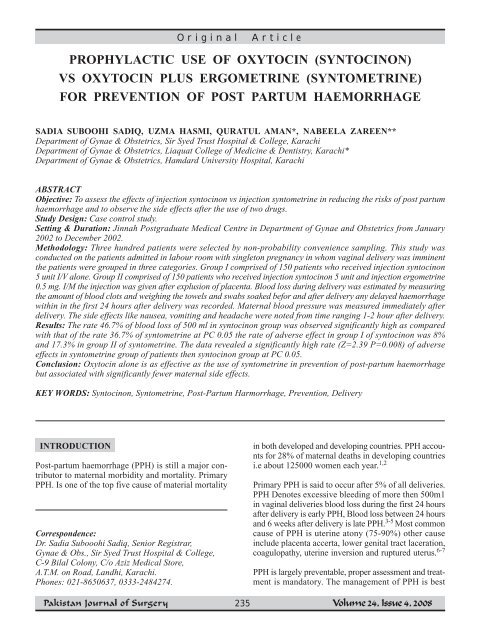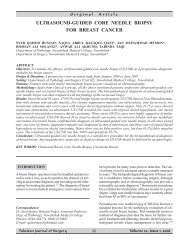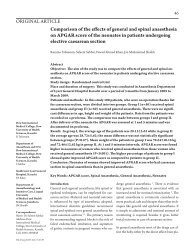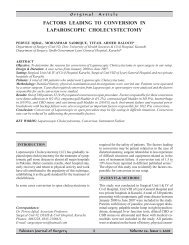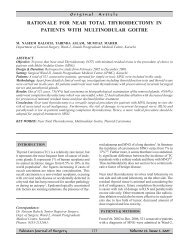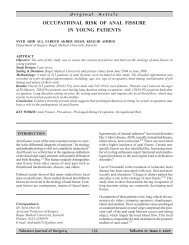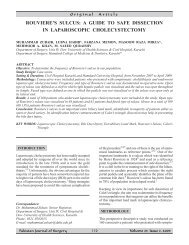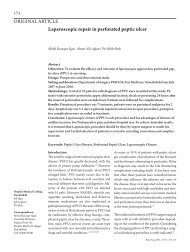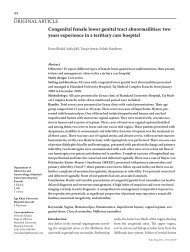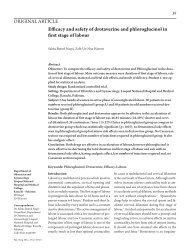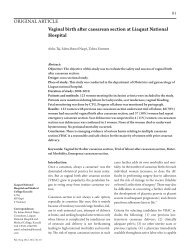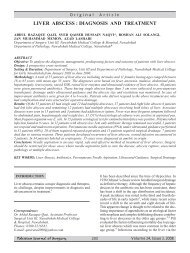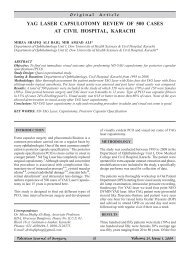PROPHYLACTIC USE OF OXYTOCIN (SYNTOCINON) VS ...
PROPHYLACTIC USE OF OXYTOCIN (SYNTOCINON) VS ...
PROPHYLACTIC USE OF OXYTOCIN (SYNTOCINON) VS ...
You also want an ePaper? Increase the reach of your titles
YUMPU automatically turns print PDFs into web optimized ePapers that Google loves.
Original Article<br />
<strong>PROPHYLACTIC</strong> <strong>USE</strong> <strong>OF</strong> <strong>OXYTOCIN</strong> (<strong>SYNTOCINON</strong>)<br />
<strong>VS</strong> <strong>OXYTOCIN</strong> PLUS ERGOMETRINE (SYNTOMETRINE)<br />
FOR PREVENTION <strong>OF</strong> POST PARTUM HAEMORRHAGE<br />
SADIA SUBOOHI SADIQ, UZMA HASMI, QURATUL AMAN*, NABEELA ZAREEN**<br />
Department of Gynae & Obstetrics, Sir Syed Trust Hospital & College, Karachi<br />
Department of Gynae & Obstetrics, Liaquat College of Medicine & Dentistry, Karachi*<br />
Department of Gynae & Obstetrics, Hamdard University Hospital, Karachi<br />
ABSTRACT<br />
Objective: To assess the effects of injection syntocinon vs injection syntometrine in reducing the risks of post partum<br />
haemorrhage and to observe the side effects after the use of two drugs.<br />
Study Design: Case control study.<br />
Setting & Duration: Jinnah Postgraduate Medical Centre in Department of Gynae and Obstetrics from January<br />
2002 to December 2002.<br />
Methodology: Three hundred patients were selected by non-probability convenience sampling. This study was<br />
conducted on the patients admitted in labour room with singleton pregnancy in whom vaginal delivery was imminent<br />
the patients were grouped in three categories. Group I comprised of 150 patients who received injection syntocinon<br />
5 unit I/V alone. Group II comprised of 150 patients who received injection syntocinon 5 unit and injection ergometrine<br />
0.5 mg. I/M the injection was given after explusion of placenta. Blood loss during delivery was estimated by measuring<br />
the amount of blood clots and weighing the towels and swabs soaked befor and after delivery any delayed haemorrhage<br />
within in the first 24 hours after delivery was recorded. Maternal blood pressure was measured immediately after<br />
delivery. The side effects like nausea, vomiting and headache were noted from time ranging 1-2 hour after delivery.<br />
Results: The rate 46.7% of blood loss of 500 ml in syntocinon group was observed significantly high as compared<br />
with that of tbe rate 36.7% of syntometrine at PC 0.05 the rate of adverse effect in group I of syntocinon was 8%<br />
and 17.3% in group II of syntometrine. The data revealed a significantly high rate (Z=2.39 P=0.008) of adverse<br />
effects in syntometrine group of patients then syntocinon group at PC 0.05.<br />
Conclusion: Oxytocin alone is as effective as the use of syntometrine in prevention of post-partum haemorrhage<br />
but associated with significantly fewer maternal side effects.<br />
KEY WORDS: Syntocinon, Syntometrine, Post-Partum Harmorrhage, Prevention, Delivery<br />
INTRODUCTION<br />
Post-partum haemorrhage (PPH) is still a major contributor<br />
to maternal morbidity and mortality. Primary<br />
PPH. Is one of the top five cause of material mortality<br />
Correspondence:<br />
Dr. Sadia Subooohi Sadiq, Senior Registrar,<br />
Gynae & Obs., Sir Syed Trust Hospital & College,<br />
C-9 Bilal Colony, C/o Aziz Medical Store,<br />
A.T.M. on Road, Landhi, Karachi.<br />
Phones: 021-8650637, 0333-2484274.<br />
235<br />
in both developed and developing countries. PPH accounts<br />
for 28% of maternal deaths in developing countries<br />
i.e about 125000 women each year. 1,2<br />
Primary PPH is said to occur after 5% of all deliveries.<br />
PPH Denotes excessive bleeding of more then 500m1<br />
in vaginal deliveries blood loss during the first 24 hours<br />
after delivery is early PPH, Blood loss between 24 hours<br />
and 6 weeks after delivery is late PPH. 3-5 Most common<br />
cause of PPH is uterine atony (75-90%) other cause<br />
include placenta accerta, lower genital tract laceration,<br />
coagulopathy, uterine inversion and ruptured uterus. 6-7<br />
PPH is largely preventable, proper assessment and treatment<br />
is mandatory. The management of PPH is best
described in terms of anticipation and prevention. This<br />
includes identification of the women at the risk for<br />
uterine atony, or with history of primary PPH, the active<br />
management of third stage of labour and the routine<br />
use of Oxytocics in 3rd stage of labour. The high risk<br />
patients require adequate pre delivery counseling with<br />
full explanation of preventive measure that should be<br />
used. This includes cross matched blood in reserve,<br />
establishing access to circulation after the onset of labour<br />
by setting on Intravenous (I/V) cannula and the<br />
prophylactic use of oxytocin drugs.<br />
The drugs used for prevention of PPH are oxytocin and<br />
ergometrine given alone or in combination they may<br />
be given after the delivery of placenta. Oxytocin produces<br />
rhythmical contractions of uterus augmenting<br />
retraction and its effects noticeable about 3 minutes<br />
after Intramuscular (I/M) injection. An Intravenous<br />
injection of 5 units of oxytocin produce effective contractions<br />
for about 15 minutes.<br />
An I/M injection of ergometrine will result in a more<br />
prolonged contraction with retraction. 8 There seems to<br />
be no place for prophylactic use of ergot alkaloids. 9<br />
The prophylactic use of oxytocin drug is now well<br />
established but difference in technique of administration<br />
and in selection of drug still exist.<br />
There are strong suggestions, of benefit for oxytocin in<br />
terms of PPH as compared to syntometrine or ergometrine.<br />
10 The prophylactic administration of oxytocin<br />
alone is as effective as the use of oxytocin plus ergometrine<br />
in prevention of PPH but is associated with lower<br />
rate of side effects. 11-12<br />
No proper study has been conducted to determine the<br />
safety and efficacy of oxytocin alone in our population.<br />
Keeping in view of the significance of this subject. A<br />
study is designed to delineate the role of syntocinon in<br />
third stage of labour for prevention of PPH.<br />
METHODOLOGY<br />
This case control study was conducted on the patients<br />
admitted in labour room with signleton pregnancy in<br />
whom vaginal delivery was imminent. Information<br />
regarding age, gestational age, parity, past history of<br />
PPH, hypertension, diabetes mellitus and caesaren section<br />
were noted through a structured performa. Patients<br />
with co-morbid disease such as cardiac disease, hypertension,<br />
pre-eclampsia and eclampsia or women with twin<br />
pregnancy, polyhydraminos and antepartum haemorrhage<br />
were excluded from this disease. Patients with<br />
previous history of PPH or caesarean section were also<br />
excluded. If due to any reason labour was prolonged<br />
236<br />
i.e more than 10 hours in multigravida or more than 18<br />
hours in primigravida. Those patients were excluded<br />
from the study. Women were divided in two groups,<br />
groups I comprised of 150 patients who received injection<br />
syntocinon 5 units I/V alone and group II comprised<br />
of 150 patients. Who received injection syntocinon 5<br />
units and injection ergometrine 0.5mg I/M. after admission<br />
general/systemic examination was done along with<br />
per abdominal and per vaginal examination.<br />
Towels and swabs which were used for delivery were<br />
pre-weighed and delivery was conducted on Macintosh<br />
sheets rather than towel. Injection syntocinon or syntometrine<br />
was given after delivery of placenta. Any delayed<br />
haemorrage within first 24 hours after delivery was<br />
recorded. Maternal Blood Pressure was measured immediately<br />
after delivery and repeated after 30 minutes.<br />
The duration of first, second and third stage of labour<br />
were recorded. Patients was kept in labour room under,<br />
observation for 1 hour after then patient was shifted to<br />
observation room for 4 hours during this period symptoms<br />
such as nausea, vomiting and headache was recorded.<br />
Statistical analysis was performed using the SPSS<br />
version including difference between the two groups<br />
were assesed by using chi-square test for comparison<br />
of post partum haemorrhage and z-test for rate of adverse<br />
drug effects.<br />
RESULTS<br />
There hundred patients were recruited for comparative<br />
analytical trial, of these 150. (group I) received injection<br />
syntocinon and other 159 (group II) received injection<br />
syntometrine group were analyzed into two hypothetical<br />
phase.<br />
The average age in group I was observed 27.49±6.58<br />
(ranging from 17 to 43) years while in group II, it was<br />
observed 27.17±6.27 (Ranging from 16 to 47) years.<br />
Parity status in the study was observed that 91/300<br />
(30.3%) women were come out to be primigravidas &<br />
209/300 (69.7%) were multigravida. The number of<br />
women which were primigravida in group I were 44/1<br />
50(29.3%) and 47/1 50(31.1%) in group II.<br />
Blood loss was read in 3 ratings 300 ml, 500 ml and,<br />
> 7500 ml. The rate of more then 500 ml blood loss<br />
was observed 4.3% this rate in group I was 4.7% while<br />
4% in group II. Thus there was a non-significant difference<br />
was observed in both groups regarding the amount<br />
of blood loss > 500 m1 at P < 0.05. The rate of blood<br />
loss of 300 ml in group I was 48.7% and 59.3% in<br />
group II which was significantly different P < 0.05. The
ate of 46.7% of blood loss of 500 ml in group I was<br />
observed significantly high as compared with that of<br />
the rate of 36.7% of group I at p < 0.05. (Table I).<br />
Over all 38(25.33%) patients showed adverse effect<br />
after the treatment. The rate of adverse effects in<br />
Group I was 8% and 17.3% in group II.<br />
The data revealed a significantly high rate of adverse<br />
effects IV syntometrine group of patients than syntocinon<br />
group. Nausea was the most common side effect<br />
observed. It was seen in 17 out of 300 patients (5.67%)<br />
out of which 5(3.7%) were found in group I and 12(8%)<br />
were found in group II.<br />
Headach occurred in 14 out of 300 patients, (4.67%)<br />
patients 5 out of 150(3.9%) cases of group I and 9 out<br />
of 150(6%) cases of group II. Four (1.33%) patients<br />
suffered from vomiting. This was seen in 1(0.7) patient<br />
out of 150 in group I.<br />
Amount of Blood<br />
loss in mi’s<br />
300 ml<br />
500 ml<br />
> 500 ml<br />
Adverse effects<br />
Nausea<br />
Headache<br />
Vomiting<br />
Transient rise in<br />
Blood Pressure<br />
Transient fall in<br />
Blood Pressure<br />
237<br />
Transient rise in blood pressure was found in only 2<br />
patients of group II, while only one pt of group I had<br />
transient fall in blood pressure. No Statistical significant<br />
difference was observed regarding the presence of<br />
particular adverse effect in both groups at P < 0.05<br />
(Table II).<br />
DISCUSSION<br />
Table I. Amount of blood loss<br />
Maternal morality mostly result from complications of<br />
third stage of labour and in particular from post partum<br />
haemorrhage. Nearly all maternal death (99%) occur<br />
in developing world 4 Where other factors may contribute<br />
to death in the presence of severe PPH, Blood loss<br />
was the primary end points assessed in this trial. The<br />
threshold above which the diagnosis of PPH would be<br />
recorded was set at 500 ml. This was the standard protocol<br />
in the hospital, and is internationaly accepted. 13<br />
This study was a randomized trial comparing I/V Oxytocin<br />
(5 unit) with intra muscular syntometrine in third<br />
Groups<br />
Group A (Syntocinon ) n=150 Group B (Syntometrine) n=150<br />
73<br />
48.7%<br />
70<br />
46.7%<br />
7<br />
4.7%<br />
89<br />
59.3%<br />
55<br />
36.7%<br />
6<br />
4.0%<br />
Table II. Comparison of adverse effect associated with drug group<br />
Groups<br />
Group A (Syntocinon ) n=150 Group B (Syntometrine) n=150<br />
5<br />
3.7%<br />
5<br />
3.3%<br />
1<br />
0.7%<br />
0<br />
0%<br />
1<br />
0.7%<br />
12<br />
8.0%<br />
9<br />
6.0%<br />
3<br />
2.0%<br />
2<br />
1.3%<br />
0<br />
0%<br />
Significance<br />
Z = 1.74<br />
P < 0.04*<br />
Z = 1.76<br />
P < 0.03<br />
Z = 1.74<br />
P < 0.40<br />
Significance<br />
X 2 = 3.06<br />
X 2 = 1.20<br />
X 2 = 1.01<br />
P < 0.31<br />
X 2 = 2.01<br />
P < 0.16<br />
X 2 = 1.00<br />
P < 0.30
stage of labour. A prospective cohort study reported I/V<br />
oxytocin being as effective as I/M syntornetrine in<br />
prevention of post partum Haemorrhage but associated<br />
with a significantly higher rate of unpleasant maternal<br />
side effects that are nausea, vomiting, headache, rise in<br />
blood pressure. 13<br />
Result from our study confirmed the efficacy of IJV<br />
Oxytocin in preventing PPH with a lower risk of Hypertension.<br />
The superior prophylactic effects of I/V over<br />
I/M Oxytocin is likely to be related to the early onset<br />
of the action of I/V administration, as suggested by<br />
Soriano 14 early delivery of uterotonic drug is associated<br />
with a lower risk of PPH. The benefits of oxytocinover<br />
syntometrine should not be undermined by a rigid approach<br />
toward the route of administration of the drugs.<br />
Unpleasent maternal side effect well reputed with the<br />
use of syntometrine and the incidence in the western<br />
studies was as high as 20-30% 15 in this study the use<br />
of syntometrine was associated with a significant increase<br />
in the risk of nausea 8.0%, vomiting 2.0%, headache<br />
6.0%. the high rate of side effects associated with the<br />
use of syntometrine as observed in the current study<br />
has been well recognized by Nieminen 16 and Dumoulin.<br />
17 Other maternal side effects like pulmonary oedema,<br />
fluid retention were not observed in the presented trial.<br />
This study contributes to this debate only as far as<br />
showing that oxytocin can be safely, administered intravenously<br />
safety, its probably the drug of choice.<br />
CONCLUSION<br />
In conclusion there are no important clinical difference<br />
the effective of intramuscular syntometrine and intravenous<br />
oxytocin for the prevention of post partum blood<br />
loss.<br />
The magnitude of the reduction in PPH revealed in our<br />
trial suggest the use of oxytocin.<br />
As oxytocin alone is as effective as the use of syntometrine<br />
in prevention of PPH, But associated with significantly<br />
fewer maternal side effects therefore it is concluded<br />
that oxytocin can be use prophylactically to prevent<br />
PPH.<br />
REFERENCES<br />
1. Franchine M. Post-partum Haemorrhage: new therapeutic<br />
option. Recenti Prog Med 2007; 98(1):7-11.<br />
2. Kavle J A , Khalfan S S, Soltz fus R J, Writter F,<br />
Fielsch J, Caul field L E. Measurment of Blood<br />
Loss at child birth post partum Int J Gynaecol obstet<br />
2006; 95(1): 24-8.<br />
238<br />
3. Magann E F, Evan S, Chauhan S P, Lanneau G,<br />
Fisk A D, Morrison J C. The length of the third<br />
stage of labour and risk of post partum haemorrhage.<br />
Obstet Gynecol 2005;105(2): 290-3.<br />
4. Joke M J Bais, Martine E, Maria P, Gouke J B, Otto<br />
P B. Postpartum haemorrhage in nulliparous women:<br />
incidence and risk factors in low and high risk<br />
women. A Dutch population-based cohort study on<br />
standard (> or = 500ml) and severe (> or = 1000ml)<br />
postpartum haemorrhage. Eur J Obstet Gynaecol<br />
Reprod Biol 2003; 115(2): 166-72.<br />
5. Mousa H A. Alfirevicz Z. Treatement for Primary<br />
PPH. Cochrane Database Syst Rev 2007; 24(1):<br />
CD 003249.<br />
6. Pierzynski P, Urban R, Law danski T, Urban J. By<br />
Lynch Suture of PPH due to uterine, atony. Ginekol<br />
Pol 2006; 77(2): 146-50.<br />
7. Saha R, Sharma M, Karki C, Pande S B-Lynch<br />
Brace Suture simple surgical Technique for managing<br />
post partum Hameorrhage report of 3 casses<br />
Kathmandu Univ Med J 2005; 3(4): 418-20.<br />
8. Beazley J M. White field charles R. Third stage of<br />
labour. Natural labour and active management.<br />
Dewhurst's Textbook of Obstetrics and Gynaecology<br />
for postgraduates 7th Ed. Keith Edmonds (Editor)<br />
London.<br />
9. Liabsuetrakul T, Choobun T, Peeyananjarassri K,<br />
Islam Q M. Prophylactic use of ergot alkaloids in<br />
the third stage of labour. Cochrane Database Syst<br />
Rev. 2007; 18(2): CD 005456.<br />
10. Fujimoto M, TaKeuchi K, Sugimoto M, Marout<br />
Prevention of Post partum haemorrhage by uterotonic<br />
agents: comparison of oxytocin Methylergom<br />
trine the management of the third stage of labour<br />
Acta Obstet Gynaecol Scand 2006; 85(11):1310-4.<br />
11. Manghan K L, Hein S W, Galazka S S. Preventing<br />
PPH: managing the third stage of labour Am Fam<br />
Physician 2006; 73(6): 1025-8.<br />
12. Mc Donalds, Abbot J M, Higgins S P. Prophylactic<br />
ergometrine - versus oxytocin Oxytocin for the third<br />
stage of labour. Cochrane database syst rev 2004;<br />
1: CD 00201 .<br />
13. Abu-Omar A A. Prevention of post-partum haemorrhage<br />
safety and efficacy: Saudi Med J 2001; 22(12):<br />
118-21.
14. Soriano P, Dulitzki M, Shiff E, Barkai G, Mashiach<br />
S, Seidman P S. A prospective cohort study of oxytocin<br />
alone for prevention of post-partum haemorrhage<br />
Br J Obstet Gynaecol 1996; 103: 1068-73.<br />
15. Mc Donald Prendville W J, Elbourne D. Prohylactic<br />
syntometrine versus oxylocin for delivery of the<br />
placenta. Cochrane Database of systematic review<br />
239<br />
2001; 1.<br />
16. Nieminen U, Tarvinen P A. A comparative study of<br />
different medical treatment of the third stage of<br />
labour. Ann Chir Gynaecol Fenn 1963; 53: 424-29.<br />
17. Dumoulin J G. A reappraisal of the use of ergometrine.<br />
J Obstet Gynaecol 1998; 1: 178-81.


